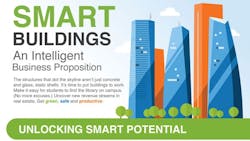Honeywell Survey: Intelligence of U.S. Buildings Is Low
A survey of operators of nearly 500 buildings in seven major U.S. cities by Honeywell and KRC Research shows the intelligence of U.S. buildings generally is low.
Honeywell Smart Building Score is a global index used to evaluate facilities based on their use of 15 technology assets, which fall into one of three groups:
- Green assets, which include use of natural resources, flexible heating and cooling systems, and control panels for monitoring energy consumption.
- Safe assets, which include access control, surveillance and intrusion monitoring, fire systems, emergency communications, and health and life-safety systems.
- Productive assets, which include indoor-air-quality sensors, lighting systems, data and communications infrastructure, and backup electricity systems.
On a scale of 1 to 100, the average Smart Building Score among the facilities surveyed is 35.
The survey covered eight building types: education, airport, hospital, high-rise residential, government office, hotel, private office, and retail. Airports (50), government office buildings (46), and hospitals (45) were the smartest, while high-rise residential buildings (31) and private office buildings (31) were the least smart.
Public buildings scored higher than private buildings regarding green (40 vs. 35), safe (47 vs. 35), and productive (41 vs. 32) assets, with an overall score of 43 compared with private buildings’ 34.
The top three scoring assets were fire-detection systems, efficient appliances and fixtures, and remote access/wired infrastructure.
Survey participants were asked to assess their buildings. Participants consistently overrated the intelligence of their facilities, with an average difference between perceived score and real score of more than 20 points. Operators of hospitals and government office buildings often were closest to the mark, while operators of hotels and residential high-rises tended to give the most inflated assessments.
The survey found building operators prioritize safety and security over sustainability and productivity, with 51 percent citing safety as the primary gauge of a smart building, 27 percent citing green assets, and 22 percent citing productive assets.
While 82 percent of the respondents agreed about the beneficial nature of energy efficiency, only 53 percent believe their building is “technologically advanced” enough to maximize efficiency.
The buildings that were evaluated are located in Atlanta, Boston, Chicago, Dallas, Los Angeles, New York, and Washington, D.C.
The survey builds on similar research Honeywell conducted in India earlier this year. U.S. buildings scored much higher in the deployment of safety-focused technologies, while facilities in India are more sophisticated when it comes to green strategies and tools.
“There’s an emerging opportunity for buildings to make real contributions to an organization’s mission,” Alex Ismail, president and chief executive officer of Honeywell Automation and Control Solutions, said. “In addition to helping keep occupants healthy, safe, and productive, smart buildings can drive top-line growth and bottom-line profits, making facilities strategic assets instead of overhead.”
Honeywell and analyst firm IHS prepared a white paper, “Put Your Building to Work: A Smart Approach to Better Business Outcomes,” detailing how targeted investment in smart buildings can be used to drive economic and environmental benefits and help to protect human life and building assets. To download the whitepaper, go to www.buildingscore.honeywell.com/US.

